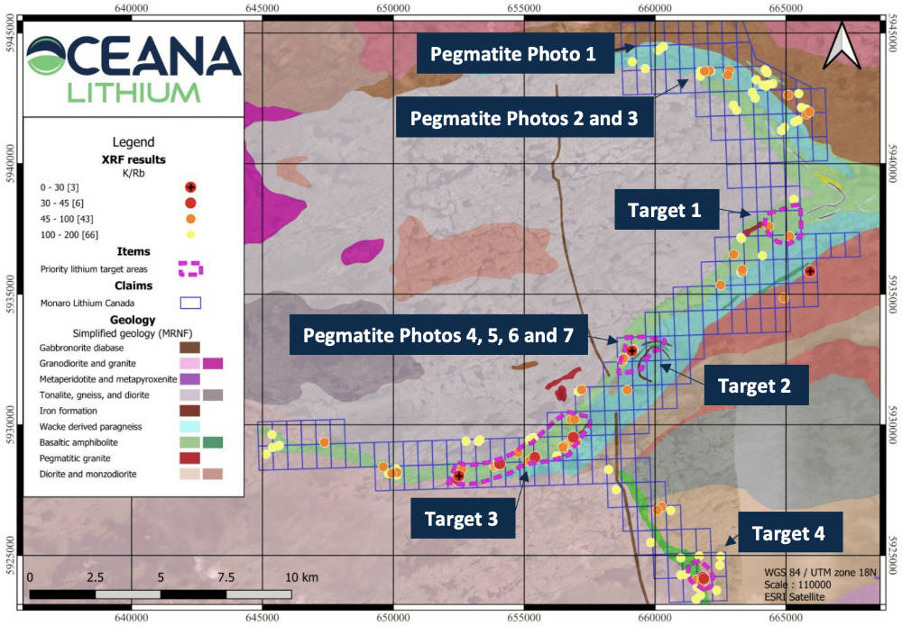Up 20pc: Oceana Lithium changes gear at Monaro as high priority lithium targets identified

Oceana first phase exploration has thrown up plenty of lithium targets to work through at Monaro. Pic: Toa55 via Getty Images.
- Low potassium/rubidium ratio– a strong lithium indicator – observed in four zones during field work at Oceana’s Monaro project in James Bay
- First phase field exploration also identified 356 new pegmatites
- Company up 20% in early trade
Special Report: Oceana Lithium has sped off the start line at its Monaro project in Quebec’s red-hot James Bay region with first phase field exploration identifying several high priority lithium targets.
In July, the company secured an exclusive six-month option to purchase the 104km2 Monaro project, which covers highly prospective Archean rocks within a region with numerous discoveries including Patriot Battery Metals’ impressive 109.2Mt Corvette discovery and Allkem’s 110.2Mt James Bay deposit.
It means Oceana Lithium (ASX:OCN) now has ground in three of the world’s lithium hotspots, the others being Brazil and the Northern Territory.
While nearology might have drawn the company’s attention to Monaro, it is the presence of 40km of contiguous greenstones that known to host lithium-caesium-tantalum mineralisation that sealed the deal.
These greenstones share the same geological setting as Winsome Resources’ (ASX:WR1) Adina lithium discovery.
This prospectivity led OCN to work together with vendors to roll the ground into a single consolidated package for the first time ever before it launched field work in August.
“Oceana is very pleased to have already identified four high priority targets in the first phase of field exploration at Monaro, which are consistent with the current LCT pegmatite spodumene-bearing targeting model for the James Bay area,” Oceana CEO Caue Araujo told Stockhead.
“We look forward to receiving the results from the 175 rock samples submitted to the lab.”
On the hunt

OCN has now received preliminary results from its first phase field exploration program and every indicator says the company’s belief in Monaro’s lithium prospectivity was well placed.
Portable XRF work on samples collected from pegmatite outcrops found four zones with low potassium/rubidium ratios – a known indicator for lithium fertility.
While pXRF is no replacement for laboratory assaying, it does provide a good hint of what to expect from the 175 samples that have been sent to ALS Laboratories in Val-d’Or, Québec, for whole rock analysis.
Given that some of the pegmatites are mapped over 1km long and up to 80m wide, confirming the presence of lithium could be potentially very significant for OCN.
The company also identified over 356 new pegmatites of which 317 have been ground-checked, leading to the discovery of 131 new pegmatite bodies and 68 pegmatite boulders.
OCN has flown high-resolution LiDAR over the Monaro claims to assist with pegmatite target identification, measurement and prioritisation.
Additionally, the project’s geology containing both amphibolites and wacke para-gneiss fits well within the current LCT pegmatite spodumene-bearing targeting model for the James Bay area.
Next steps
Once the whole rock analyses are received, which are expected in December, the company will identify drill-ready outcrop targets for first phase drilling.
This will also allow planning for further focused geophysics, channel sampling and soil/till sampling campaign over the highly evolved pegmatite areas to identify additional lithium-bearing drill targets to begin.
Meanwhile, shareholder approval will be sought at the upcoming annual general meeting on 28 November to issue shares and performance rights that form part of the deferred consideration to exercise the option over Monaro.
This article was developed in collaboration with Oceana Lithium, a Stockhead advertiser at the time of publishing.
This article does not constitute financial product advice. You should consider obtaining independent advice before making any financial decisions.
Related Topics

UNLOCK INSIGHTS
Discover the untold stories of emerging ASX stocks.
Daily news and expert analysis, it's free to subscribe.
By proceeding, you confirm you understand that we handle personal information in accordance with our Privacy Policy.








